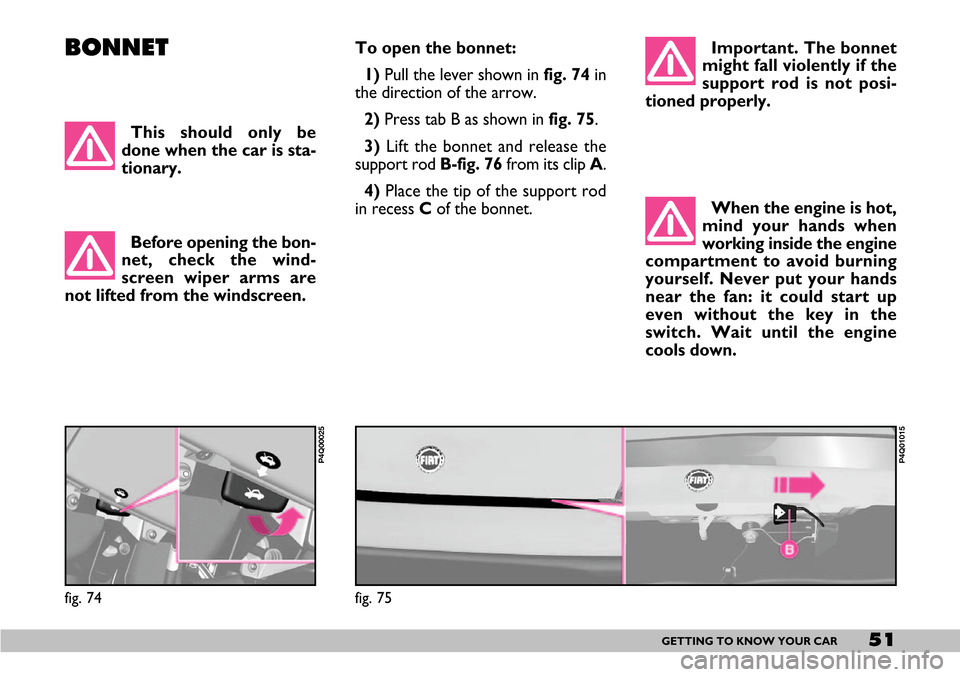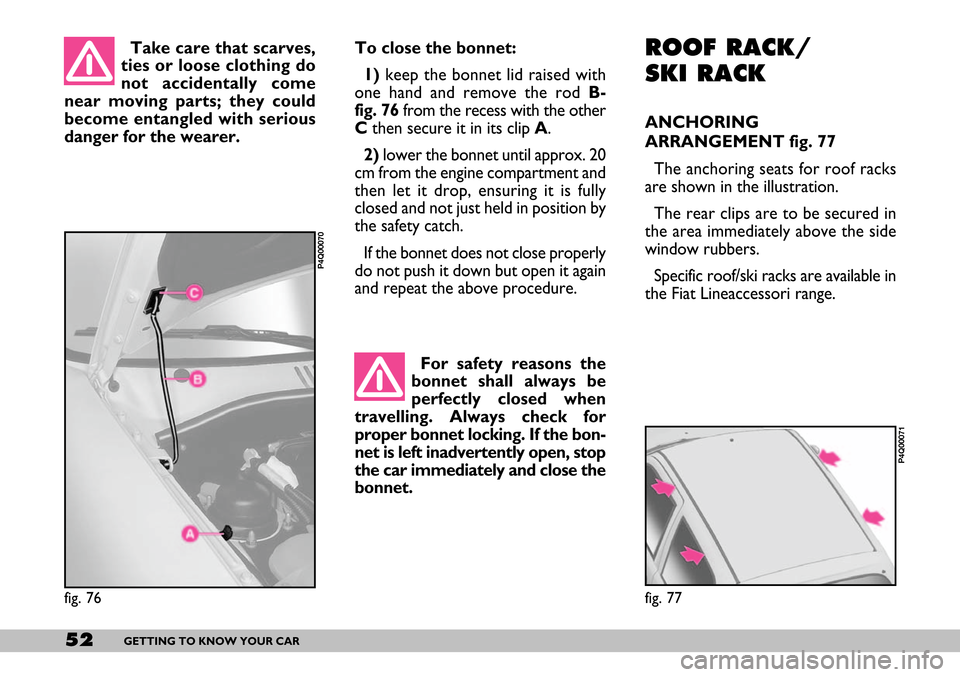2007 FIAT SEICENTO Fig 23
[x] Cancel search: Fig 23Page 52 of 154

51GETTING TO KNOW YOUR CAR
BONNETTo open the bonnet:
1) Pull the lever shown infig. 74in
the direction of the arrow.
2)Press tab B as shown in fig. 75.
3) Lift the bonnet and release the
support rod B-fig. 76from its clip A.
4)Place the tip of the support rod
in recess C of the bonnet.Important. The bonnet
might fall violently if the
support rod is not posi-
tioned properly.
This should only be
done when the car is sta-
tionary.
Before opening the bon-
net, check the wind-
screen wiper arms are
not lifted from the windscreen.
When the engine is hot,
mind your hands when
working inside the engine
compartment to avoid burning
yourself. Never put your hands
near the fan: it could start up
even without the key in the
switch. Wait until the engine
cools down.
fig. 74
P4Q00025
fig. 75
P4Q01015
Page 53 of 154

52GETTING TO KNOW YOUR CAR
Take care that scarves,
ties or loose clothing do
not accidentally come
near moving parts; they could
become entangled with serious
danger for the wearer. To close the bonnet:
1)keep the bonnet lid raised with
one hand and remove the rod B-
fig. 76from the recess with the other
Cthen secure it in its clip A.
2) lower the bonnet until approx. 20
cm from the engine compartment and
then let it drop, ensuring it is fully
closed and not just held in position by
the safety catch.
If the bonnet does not close properly
do not push it down but open it again
and repeat the above procedure.ROOF RACK/
SKI RACK
ANCHORING
ARRANGEMENT fig. 77
The anchoring seats for roof racks
are shown in the illustration.
The rear clips are to be secured in
the area immediately above the side
window rubbers.
Specific roof/ski racks are available in
the Fiat Lineaccessori range.
For safety reasons the
bonnet shall always be
perfectly closed when
travelling. Always check for
proper bonnet locking. If the bon-
net is left inadvertently open, stop
the car immediately and close the
bonnet.
fig. 76
P4Q00070
fig. 77
P4Q00071
Page 54 of 154

53GETTING TO KNOW YOUR CAR
After travelling a few
kilometres, check that
the screws securing the
attachments are tight.
Never exceed the per-
mitted weight (see
TECH-
NICAL SPECIFICATIONS). SLANT COMPENSATION
When the car is loaded, it slopes
backwards. This means that the head-
light beam rises. In this case, it is nec-
essary to return it to the correct po-
sition.
The headlight beam adjuster is lo-
cated inside the car on the right side
of the steering column fig. 78.
Position 0- one or two occupants in
the front seats.
Position 1- five occupants.
Position 2- five occupants + load in
boot.
Position 3- driver + maximum per-
missible load stowed in boot.
Be careful not to knock
objects on the roof rack
when opening the tail-
gate.
HEADLIGHTS
ADJUSTING THE
HEADLIGHT BEAM
The correct positioning of the head-
light beams is very important for the
comfort and safety, not only of the
person driving the car but also all
other road users.
This is also covered by a specific law.
To ensure you and other drivers
have the best visibility conditions
when travelling with the headlights on,
the headlights must be set properly.
Have the headlight positioning
checked at a Fiat Dealershipand
adjusted if necessary.
fig. 78
P4Q01016Check the positioning of
the headlight beams
every time you change
the load to be carried.
Page 55 of 154

54GETTING TO KNOW YOUR CAR
ADJUSTING THE FRONT
FOGLIGHTS
The foglight beam can be adjusted by
means of screw A-fig. 79.
Have the lights checked at a Fiat
Dealershipand adjusted if necessary. If you have never driven a car with
ABS before, you should practice using
the system on slippery terrain, obvi-
ously with the necessary safety pre-
cautions and keeping to the Highway
Code of the country you are in. It is
also a good idea to read the following
information carefully.
The advantage in using the ABS sys-
tem is that it continues to give you
maximum manoeuvrability even when
braking hard in conditions of poor grip
by preventing the wheels locking.
You should, however, not expect
the braking distance to always de-
crease: for example surfaces with
gravel or fresh snow on a slippery
road will in fact increase the braking
distance.
To exploit the ABS system to the full
in the event of necessity, you should
take heed of the following advice:ABS
The car is fitted with an ABS braking
system, which prevents the wheels
from locking when braking, makes the
most of road grip and gives the best
control when emergency braking un-
der difficult road conditions.
The driver can tell the ABS system
has come into play because the brake
pedal pulsates slightly and the system
gets noisier.
This should not be interpreted as a
fault in the brakes; on the contrary it
is a sign that the ABS system is work-
ing: it tells the driver that the car is
travelling at the limit of its road grip
and that the speed should be altered
to fit the type of road surface.
The ABS is an addition to the basic
braking system. If there is a malfunc-
tion, the system turns off automati-
cally and only the ordinary brakes
continue to work.
If a failure occurs, and, consequently,
the wheel anti-locking system is not
effective, the braking system will con-
tinue to work as usual.
fig. 79 Versione S and Active
P4Q01017
Page 57 of 154

56GETTING TO KNOW YOUR CAR
Warning light >alone,
with the engine running,
normally indicates a fault
in the ABS system only. In this
case, the braking system is still
efficient, though without the
anti-locking device. Under these
conditions, performance of the
EBD system may be reduced.
Also in this case, you are advised
to go immediately to the nearest
Fiat Dealership, driving in such a
way to avoid sharp braking to
have the system checked. FRONT AIRBAGS
The car is fitted with front air bags
(for versions/markets where applica-
ble) for the driver and the passenger.
FRONT AIR BAGS fig. 80
The front air bag (driver and pas-
senger) has been designed to protect
the occupants in the event of head-
on crashes of medium-high severity,
by placing the cushion between the oc-
cupant and the steering wheel or dash-
board.
Front air bags are designed to pro-
tect car’s occupants in front crashes
and therefore non-activation in other
types of collision (side collisions, rear
shunts, roll-overs, etc.) is not a system
malfunction.In case of front crash, an electronic
control unit, when required, triggers
the inflation of the cushion.
The cushion immediately inflates,
placing itself as a protection between
the body of the front occupants and
the structure that could cause injuries.
Immediately after, the cushion deflates.
The front air bag (driver and pas-
senger) is not a replacement of but
complementary to the use of belts,
which should always be worn, as spec-
ified by law in Europe and most non-
European countries.
In case of crash, a person not wear-
ing the seat belt moves forward and
may come into contact with the cush-
ion while it is still inflating. Under this
circumstance the protection offered
by the air bag is reduced.
Front air bag can be activated in the
following situations:
– in collisions against highly
deformable objects not affecting
the vehicle front surface (e.g.
bumper collision against guard
rail); If the xbrake fluid low
warning light comes on,
stop the vehicle immedi-
ately and contact the nearest
Fiat Dealership. Fluid leaks from
the hydraulic system, in fact, can
compromise brake system oper-
ation, both traditional systems
and systems with ABS.
fig. 80
P4Q00074
Page 58 of 154

57GETTING TO KNOW YOUR CAR
Do not apply stickers or
other objects to the
steering wheel or to the
passenger's air bag cover or on
the side roof lining. Never apply
objects on the dashboard on pas-
senger side (e.g. mobile phones)
since they could interfere with
proper passenger air bag inflation
and cause severe injuries. – car wedging under other vehicles
or protective barriers (for
example under a truck or guard
rail);
as it offers no additional protection
compared with the seat belts, conse-
quently, it would be pointless. There-
fore, failure to come into action in the
above circumstances does not mean
that the system is not working prop-
erly.FRONT AIRBAG
PASSENGER SIDEThe passenger side airbag was de-
signed and calibrated to protect a per-
son wearing seat belts.
When fully inflated, the bag will fill
most of the space between the dash-
board and the passenger.
Manual deactivation
The passenger side airbag can be de-
activated if it is absolutely necessary
to carry a child in the front passenger
seat.
Turn the specific control switch un-
der the middle of the dashboard be-
tween the sound system compart-
ment and the oddment compartment
fig. 81with the ignition key to deac-
tivate the airbag. SERIOUS DAN-
GER: Never place
cradle child’s seats
on the front passenger seat of
cars fitted with passenger air bag.
Air bag activation could cause se-
rious injuries, even mortal. In the
case of need, always deactivate
the passenger’s air bag when a
child’s seat is placed on the front
seat. The front passenger’s seat
shall be adjusted in the most
backward position to prevent any
contact between child’s seat and
dashboard. Even if not compul-
sory by law, you are recom-
mended to reactivate the air bag
immediately as soon as child
transport is no longer necessary.
fig. 81
P4Q00183
Page 62 of 154

61GETTING TO KNOW YOUR CAR
ELECTRICAL POWER
STEERING SYSTEM
IMPORTANT The electrical
power steering system only works
when the ignition key is at MAR.
A new electrically controlled power
steering system called EPAS (Electri-
cal Power Assisted Steering) is fitted
in the Fiat 600.
The EPAS system is operated by an
electric motor and consists of only
two parts: a steering column with
built-in electric motor and an elec-
tronic control unit.
The control unit processes the data
from the various sensors located in
the car and converts the signals into
commands for the power steering
motor to reduce the effect on the
steering wheel both when parking and
when cornering.
P4Q00503
fig. 82
1)Electronic power assisted steering control unit;
2)Car speed sensor;
3)Injection control unit;
4)Electric power steering motor;
5)Electrical power steering unit.
Page 64 of 154

63GETTING TO KNOW YOUR CAR
IMPORTANT Sudden braking or
collisions can cause sudden shifts of
the load which could jeopardise the
safety of the driver and the passen-
gers: before you start off make sure
the load is firmly secured.Use metal cables, ropes or straps
strong enough to support the weight
of the load to be fixed.In addition to these general precau-
tions, some simple measures could
enhance driving safety, comfort and
the length of your vehicle’s life:
– distribute the load evenly over the
load floor: if you need to concentrate
it all in one point choose the part be-
tween the axles;
– remember that the lower the load
is, the lower the vehicle’s centre of
gravity will be, contributing to a safe
drive; you should therefore always po-
sition the heavier goods at the bottom;
– finally, remember that the way in
which the vehicle moves is influenced
by the weight being carried. In partic-
ular, stopping distance lengthens par-
ticularly at high speed.
P4Q00568
fig. 83